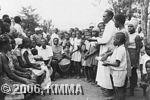



Other names: enjogyera, amayombera, amakwaita.
The amajugo is a metal ankle rattle made up of several small metal bells, each containing one small loose metal ball that acts as a clapper. Each individual bell measures 2 to 3 cm and the number of bells per amajugo can vary from 3 to 6. They are tied together with a cord made of plant fibre or sinew. The bells have two small holes at the top and the cord is pulled through these holes. The bells are also attached to the dancers' ankles with that same cord.
Whereas metals used to be extracted in a number of regions in Ankole (Bukanga, Buhweju, Mugogo, etc.), today there are only a few blacksmiths left and those who are still practising their trade now recycle metal from all kinds of sources (cars, agricultural machinery, etc.) instead of using the local ore as they did in the past. The production method has remained the same, however, as the metal is heated in the ovens and then hammered into the desired shape.
The amajugo, used by both men and women, are only worn around the ankles, whereas the eijugo, the single metal bell, can be worn on the ankles as well as on the hips and thighs.
The amajugo used to be prevalent all over Ankole, but their use is gradually decreasing. The Kiga used to make even smaller bells that were sewn to the rims of the girls' and women's dance costumes (amayombera), but this practice has also disappeared.
The amajugo are always used in combination with other instruments, primarily drums and rattles. The Iru, Kiga, Tagwenda, Kunta and the Kooki wear them only when dance music is played. Among the Hima, the men also wear them when performing an ekyevugo, a eulogic recitation, to give added strength to the words as they stamp their feet to the rhythm of their declamation.
for more information see also: VAN THIEL, Paul, "Multi-Tribal Music of Ankole. An ethnomusicological study including a glossary of musical terms." Edited by the Royal Museum for Central Africa, Annales, Sciences Humaines, nr 91, 1977, 234 pp.
© KMMA/Paul VAN THIEL